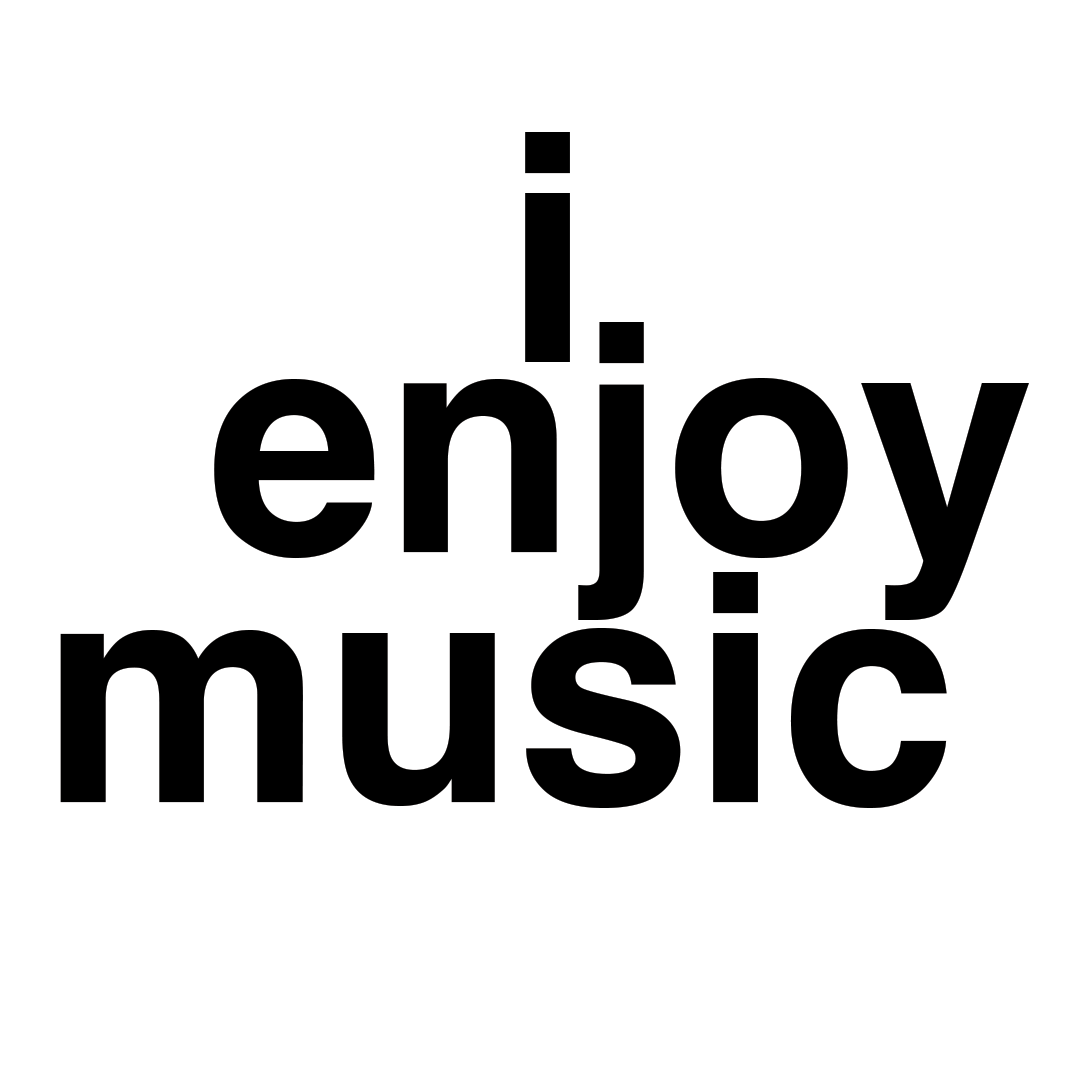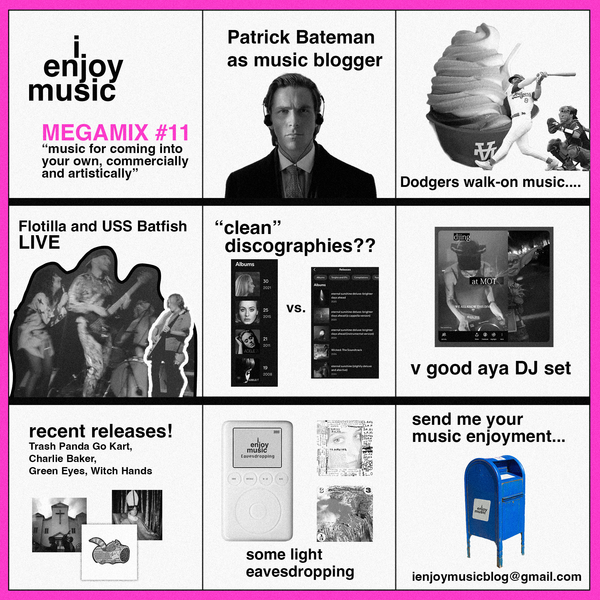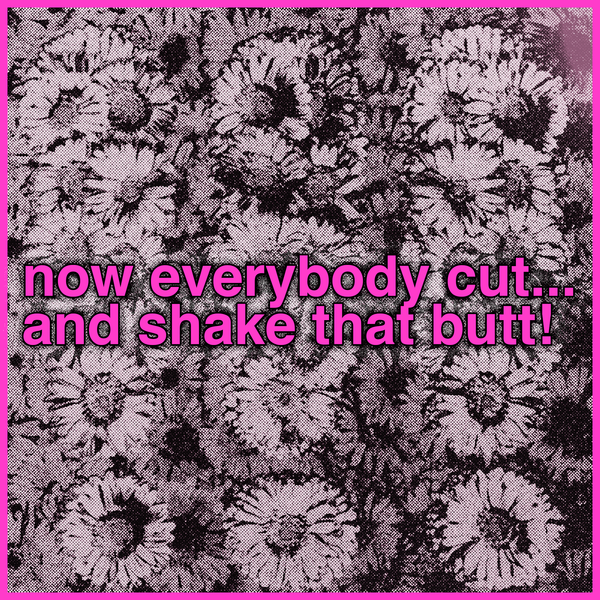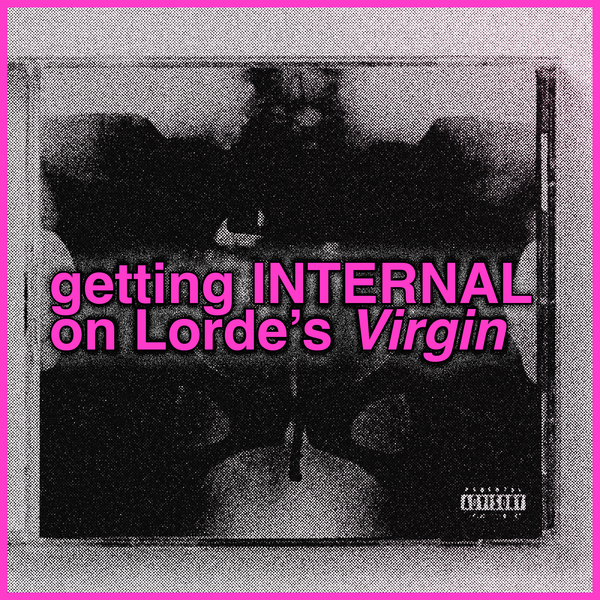caught in 4k
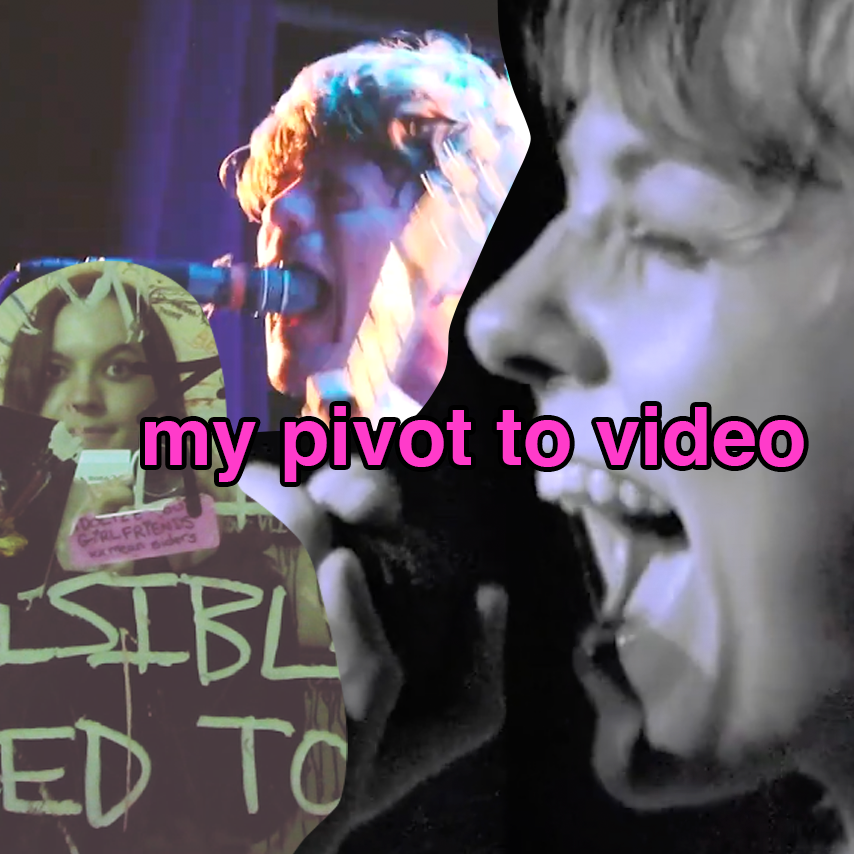
John of John's Music Blog recently posted a roundup of his favorite live show videos of the last year. I click on pretty much anything linked in JMB, just because I know it will likely lead me somewhere funky and freaky, so I delved into quite a few of the vids. I watched Big Clown play Goner Fest in Memphis, and Target Scammers play in a library in Amherst, and the ADRENODOME rave at Trans-Pecos in NYC, and I had a realization which was...
...wow...
....people still like it when concert footage kind of looks like ass!
Validation washed over me like cheap beer sprayed in a mosh pit. My gaze misted over and my thoughts returned to the period of time from 2018 to 2021 when I was an intrepid concert videographer in New York City, posting endless clips, hoping the way I filmed live music might be interesting to someone else.
I got into video production in a sideways manner. I had been doing marketing for tech startups, and then in 2015 I got a job at Snapchat, sorting user-generated videos into "global stories." This was a process I didn't understand as simply "editing video" until quite a while into the job, probably because I was delirious from my random, round-the-clock schedule. After Snapchat, I took an associate video producer role at a media company, and then my manager taught me how to edit in Premiere, and then I bought a camera and started shooting on it.
I'd majored in English in college, and writing had been my thing since I was a kid. But it felt interesting to make stuff you had to watch and listen to. The technology had gotten really cheap and easy to use, too. The last time I had made a video, it was with a VHS camcorder and no editing suite to speak of. Now everything was digital and crisp and accessible. Anyone could be a professional, even me.
The subject I wanted to shoot most was live music. I have always enjoyed a good concert documentary, a love I can pinpoint to the arrival of my family's first-ever desktop computer (1998, I think?), which came in a cow print cardboard box along with a suite of media, including a DVD from Warner Music Group that contained curated concert footage from label artists like Eric Clapton and Madonna. The first song on the DVD was Alanis Morissette's "All I Really Want," from her Jagged Little Pill, Live concert film.
There are legible artistic choices in this "All I Really Want" video, even if they're '90s as hell: weird frame rates, black-and-white inserts, blue tints, blurry lights, blown-out shots that look abstract and moody. It all helped me to understand who Alanis Morissette was as an artist, subconsciously cementing her in my mind as an "alternative" artist, even though I was too young to understand what she was an "alternative" to.
Watching it now, I see what I absorbed as a grade school kid: live music video didn't need to be a perfect documentary, a football game you could rewatch on SportsCenter. Live music video could mimic how a concert made you feel. Never mind that I hadn't even been to a concert yet.
So that filmmaking vibe got into my bones, and 20 years later, I started shooting concerts. I did not read any manuals. I did not study, which was a switch-up from my usual academic approach to new skills. I just started doing it, learning as I went. I began with all my camera settings on auto and flicked the dials to manual one by one as I figured them out.
I cold-emailed people like crazy. What's cooler than being cool? Ice-cold...emails. The first music I officially shot was in 2018: a live set by a very gracious singer-songwriter named Caitlin Mahoney, who let me film her performance at Rockwood Music Hall even when I had zero sample clips to show her.
[you can see my amateur status in this video...two camera angles, and they're basically identical...fantastic work, Molly...also that bassist accompanying Caitlin is Jeni Magaña, who, in addition to her own solo career, has been the touring bassist for Mitski for years now]
I felt an instant schism in how I wanted to approach videography. On one hand, I wanted to achieve the super high-resolution look that I was seeing on Instagram and YouTube at the time. Casey Neistat vlogs, things of that nature. When I was making videos, even regular consumer cameras were expanding past traditional HD, stacking Ks on top of Ks. It was possible to get a wildly crispy picture, if you wanted one. On the other hand, I was drawn to the purposefully "bad" look of camcorders and cheap point-and-shoots, partially because I thought that look worked well in the context of live music, but mostly because my skills were simply not on par with professional DPs.
Also, I was very shy at shows in terms of physically taking up space. I hated squaring up at the front with my camera, potentially obstructing the view of attendees or distracting the musicians themselves. There weren't many videographers at the shows I went to, but the photographers were all at the front, fearlessly snapping, sometimes with lightning bolts of flash, even if the venue forbade it. But a photo requires only a split second of intrusion at a time. Holding my camera steady long enough to get a good take felt interminable, and I much preferred being able to squeeze into a pocket of space at the side of the stage, or even hide at the back of the venue with the camcorder aloft and my zoom on max, capturing bobbing heads beneath the performance. My apprehension resulted in decent 'crowd energy' shots, at the very least.
I was working at a wellness website and an amazing colleague of mine named Tamim was a contributor to a New York-based website called Alt Citizen, so I pitched her on a 'video zine' of different shows around town called Spectator. More exposure therapy: the more I shot, the more comfortable I got, even if I never did end up completely at ease.
I filmed many sets. Up-and-coming punk bands like Gnarcissists and Native Sun that had sharp-elbowed mosh pits. Post punk-y bands like Flasher and Public Practice. I shot Osees when they were Thee Oh Sees, in a real photo pit with a real photo pass. I shot Sloppy Jane at the now-closed DIY venue The Glove. Haley Dahl spit up blue paint and took most of her clothes off, it was awesome.
I employed hard, chaotic cuts in my edits. I threw LUTs over the clips to make the colors look weird, and hand-wrote lower third IDs for the bands, then sloppily ripped them into .pngs on Photoshop. In one episode of Spectator, I included sets from 13 bands: Cindy Cane, Flasyd, Native Sun, Yaasss, The Muckers, Delicate Steve, Dead Tenants, Russian Baths, Tunic, Flexi, Big Bliss, Cold Fronts, and Grim Streaker. Whew. I was grinding!
I hit a couple of shows a week at my peak, dressing in all black like a stagehand, taking the subway home with my lower back smarting and my camcorder in a fanny pack strapped across my chest. I tried to have as minimal a gear setup as possible, so I could move around with ease and not worry about needing to stash a backpack in a risky place; several years later, I took on probably my most professional gig as a camera operator for a big shoot at Bowery Ballroom, and was agog at the amount of equipment a real professional required. It filled a station wagon. "And this is a light load-out for me," the director said.
I was grinding, but in obscurity. Nothing 'went viral,' and I didn't feel like I had a reputation to trade on, or a 'brand' to latch onto. I felt like a cipher, so I worked hard to make my videos look unique; even if they were technically bad, they were mine. Concert videography was also clearly not a lucrative field—the type of bands I filmed barely had a budget to pay themselves, let alone a videographer. So I filled my freelance docket with corporate work, and filmed music mostly for fun.
Then the pandemic happened, and the shows abruptly stopped. I stopped shooting shows and started busying myself with Covid-safe work: editing tutorial videos for a woman whose children's art program had to go virtual, editing parenting advice videos for a therapist. I made a music video for the dream pop band Cathedral Bells, just from clips filmed around my neighborhood that I edited into oblivion. I didn't hear an amplified guitar in person for six months.
Like a lot of people whose in-person jobs got flattened by the steamroller of the pandemic, I had to rethink everything about what I wanted out of work. (To quote Cher's Twitter: "Whats going on with mycareer.") My husband told me it would be helpful to have a "north star" to point all my efforts toward. Did I want to direct live video feeds at a big festival like Coachella? Or make a concert film like Stop Making Sense? Be a tour videographer for a major artist?
I didn't know. I wanted to make art, but I wanted to be useful. I wanted to have my own creative perspective, but I was in a field where success meant taking direction from bands, from managers, from labels. I didn't know what I wanted.
After the vaccines hit but before crowds re-converged in earnest was when I took gigs that felt the most useful. I directed a livestream for the excellent, constantly-instrument-switching indie rock band Palberta. I shot livestreams for the Brooklyn venue Our Wicked Lady. I shot interviews for the New York Independent Venue Association, which advocated for Covid-shuttered venues throughout lockdown. Every production made me unspeakably nervous and tested my technical and interpersonal skills. Exhilaration and its fraternal twin anxiety accompanied me to every shoot.
It might have been the sheer lack of interaction with strangers during the peak pandemic. It might have been the result of taking a clear-eyed look at the reality of being a professional camera operator, which is a physically demanding, relatively thankless job whose gender imbalance, though improving, was sometimes tough for me to navigate. But something in my perspective shifted in 2020, and I started to think about my desire to "capture music" as something that could be editorial, rather than just observational: talking to bands, learning the narratives behind the songs.
That's when I started doing video interviews for The Alternative, a truly special music publication that encouraged every random idea I had. Which led me to asking bands about their onstage fashion, and vlogging a trip to buy a 100 Gecs CD, and interviewing veteran concertgoers about their tips for enjoying live music. Which gave me a taste for blogging again. Which eventually led me to want a blog of my own. Which is what you are reading right now.
I wasn't planning on reflecting on my videography era—which might not be over for good, but has wound down for the time being—until I saw that John's Music Blog post, with its thrilling amateur/professional footage that favored vibe over exactitude. It made me nostalgic for the time when I was drawn toward the stage with a camera in my hand, unsure of my endgame, hoping my sheer enthusiasm would make up for my lack of skill. In this era of prolific social video posting, enthusiasm now is skill. I feel like I was on the right track back then, even if no one really cared at the time. Chris Carrabba starts singing: VINDICATED, I AM SELFISH, I AM WRONG, I AM RIGHT, I SWEAR I'M RIGHT, SWEAR I KNEW IT ALL ALONG...
I watch these Spectator videos back and the only thing I can think is: THE AUDACITY! Who did I think I was, cold-pitching bands, letting frontmen fling beer at my lens, crouching down to get a good angle of a microphone-wrapped singer writhing on the floor? I didn't know what I was doing, but I was in the arena, trying things. I was 28 when it started, and the whole enterprise was so damn Return of Saturn that it might as well have been No Doubt's fourth studio album. I didn't know what I was doing, and I ended up here.
Those Alt Citizen video-zines were trial runs at what I Enjoy Music is supposed to be about, really: I try to make each post on here a micro-universe, a user experience handled with care, a little devotional.
I forgot something important about the Alanis Morissette DVD. The "All I Really Want" video footage comes primarily from an arena show in New Orleans that took place in 1996, the calendar year in which Jagged Little Pill sold 18.7 million copies. But it opens with footage from the first night of that album's 18-month world tour: July 1st 1995, five days before "You Oughta Know" was even released as a single. The venue was a 200-cap club in Wisconsin. The footage looks like it was shot with a regular consumer camcorder. There's a sudden transition from shaky handheld video to a pro-shot pan of a gigantic screaming audience as the chorus kicks in, and it is breathtaking.
Thanks for reading I Enjoy Music. If you like the blog, tell a friend!
